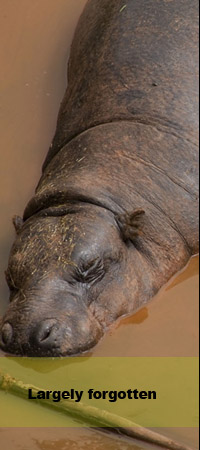|
Pygmy hippopotamus (Choeropsis liberiensis) is nocturnal and solitary, living in lowland primary and secondary forests close to rivers, streams and swamps. It feeds on terrestrial and semi-aquatic plants. Unlike the Hippo, it is a browser rather than a grazer, and feeds nocturnally on roots, water plants and fallen fruit, spending much of the day in the water. Its feet are more adapted to terrestrial life than those of its larger relative, although in other respects they share similar adaptations to aquatic life. Mating of Pygmy hippos occurs both in water and on land.
Endemic to the Upper Guinean Forests of West Africa, the pygmy hippopotamus has lost an estimated 75% of its former range and now occurs in seven remnant fragments across Sierra Leone, Guinea, Cote d’Ivoire and Liberia. The species is classified as Endangered on the IUCN Red List and the most recent population estimate, of 3,000, was made in the early 1990s but believed to be round 2,000 due to habitat loss and fragmentation that occurred in the last 30 years. The main threats to the species include habitat fragmentation, land conversion and hunting. Its threatened status, long independent evolutionary heritage, and ongoing threats make the pygmy hippopotamus in the verge of extinction.
Few people encounter pygmy hippos in the wild and local residents rarely see them because of its cryptic behavior and rarity in the wild. The best way to observe and study the pygmy hippo is to place camera traps in the forest where they find refuge. The species is admired for spiritual and aesthetic reasons and is part of the folklore of West African culture. Like the common hippopotamus (Hippopotamus amphibius), pygmy hippos play important rile in natural ecosystems by seeking higher quality vegetation and functioning as seed dispersers and nutrient recyclers by spreading dung.
Action to save the pygmy hippo in our reach
Conservation of the pygmy hippopotamus is hampered by a lack of basic biological knowledge, including details of distribution, population trends and ecology. Observational records of the species are scant because of its cryptic nature and its sharp population decline due to habitat loss and hunting. The fragmentation and destruction of the pygmy hippo's forest habitat due to logging, mining, agrobusiness expansion and farming activities have brought pygmy hippos into closer contact with humans and as a result they are at much greater risk of being hunted and disturbed by human activities.
The most important conservation action is to protect its habitat where it remains by expending and creating effective protected areas. In general, the local residents are unaware about the current extinction risk that the Pygmy hippopotamus is facing. All our field conservation initiatives are not solely reliant on the collection of ecological information, but equally on public adherence to protection of threatened animals. Awareness and perception of target species condition the intensity and orientation of public involvement in conservation initiatives. Local public awareness is therefore crucial through education and community programs at known hotspot where the pygmy hippo remains.
Protecting Nature is Protecting Ourselves. TAKE A STAND FOR NATURE. Become a monthly supporter by saving animals and wilderness.
Related links
|











